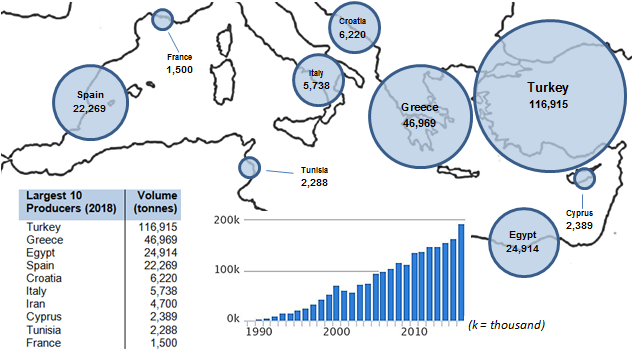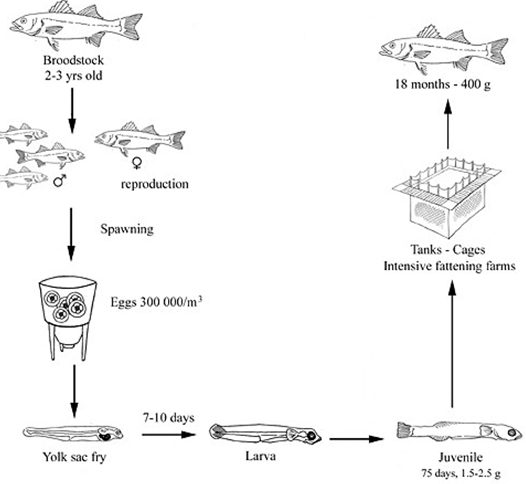European Sea Bass
Dicentrachus labrax
Sources, Quantities and Cultivation Methods
Source and Quantities
European sea bass (also known as sea bass or bass)1 is an important marine species both to commercial inshore fisheries and aquaculture. Sea bass are tolerant of a wide range of temperatures and salinities and frequent coastal inshore waters, estuaries and brackish water lagoons. Farmed European sea bass should not be confused with another farmed species often called the Asian sea bass (or barramundi) farmed in Asia, Australia and the US.
Farming of sea bass was traditionally small scale and based on the capture of wild juveniles2, but it is now predominantly undertaken intensively in net pens, largely in southern European coastal waters using hatchery-reared seed (i.e. juveniles).
Sea bass is an important aquaculture species in the Mediterranean3,4, and Turkey, Greece Egypt and Spain are the most important farming countries, as the map shows.

World production of farmed sea bass has increased steadily from around 60,000 tonnes in 2003 to 235,537 tonnes in 2018, and valued at US$1.16 billion. Turkey and Greece combined represent some 69% of world production5.
Domestic Market Information
Our domestic seafood market is complex mix of products from wild caught and farmed species, including sea bass, which in recent years, has grown in popularity in Great British retail (i.e. in England, Scotland and Wales).
To discover more about the highly dynamic and ever-changing UK and Great British (GB) seafood marketplace, you can explore our user friendly and interactive Trade and Tariff in Tableau (T4) online tool. And visiting our dedicated Insight and Research pages will provide you with access to a wealth of information, from reports to factsheets on markets including:
- Retail – data from independent and multiple retailers in the UK used to reveal the latest insights on seafood eaten at home
- Foodservice – data from the foodservice industry in the UK used to highlight the latest trends on seafood eaten out of home
- Market supply – HM Revenue and Customs (HMRC) data used to detail what species and products are imported from, and exported to, the UK
To get the latest seafood market performance and trends delivered to your inbox, register at the Market Insight Portal.
Production2, 3, 6
Sea bass were traditionally reared in enclosed lagoons where they fed naturally until harvested. Some of these early production systems are still operational today. The example of Atlantic salmon farming in Northern Europe, combined with a scarcity of juvenile sea bass for lagoon rearing, led to research programmes being initiated in the 1960s in order to intensify production. This enabled the start of commercial scale sea bass farming in coastal areas of the Mediterranean in the 1980s. A schematic of modern sea bass production is given opposite.
Until the 1990's sea bass production relied on wild caught broodstock to produce the seed for farms, however selective breeding programmes are now in place. These are generally part of larger integrated companies which control the entire process from reproduction to harvest, but there are still independent European sea bass hatcheries that sell juveniles (i.e. seed) to on-growing facilities. Along with feed, the purchase of seed is the biggest operating cost for sea bass farms.
Broodstock are kept under controlled conditions with spawning initiated using hormonal treatments and photomanipulation (control of lighting used to prolong the sea bass spawning cycle). Fertilized eggs are collected on the surface of spawning tanks, placed in incubator tanks, and hatch after 48 hours. Larvae lose their yolk sac six days after hatching. At this point they are given specialised diets, including live feeds such as rotifera (microscopic zooplankton) and artemia (a small crustacean).

After 40-50 days, the larvae are transferred to a weaning unit where they are fed a formulated high-protein ‘micro-diet’ (small pellets). After a further three to four weeks the fry are transferred to juvenile breeding units. Two months later, at 2-5g, they are ready for on-growing.
During on-growing fish are fed and reared in floating net-pens until harvest; this will be undertaken in either small cages in sheltered marine sites, or larger net-pens in more exposed locations. Although producers rear a range of sizes for market, sea bass are generally harvested when they reach 300-500g, which takes from a year and a half to two years, depending on water temperature.
There have been attempts to raise sea bass in land-based tanks, generally using recirculation aquaculture systems (RAS) that control the water temperature and minimise water usage. An example of such a system was Anglesey Aquaculture, based in North Wales. However this system ceased producing sea bass in 2015 having found it difficult to compete with imports7.